The Black Pirate (Albert Parker, 1926) is a silent pirate adventure on the Southern seas, full of impressive stunts and shot entirely in two-tone Technicolor. Douglas Fairbanks stars as the son of a duke, who vows revenge on bloodthirsty pirates responsible for his father's death. He infiltrates their band and becomes 'The Black Pirate'. But his plans for revenge become complicated when he meets his first captive - a beautiful Spanish princess, played by Billie Dove. The pace never slows down, and the film is pure fun.
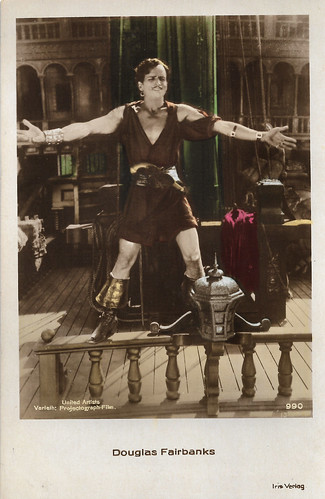
Austrian postcard by Iris Verlag, no. 990. Photo: United Artists / Projectograph-Film. Publicity still of Douglas Fairbanks in The Black Pirate (Albert Parker, 1926).
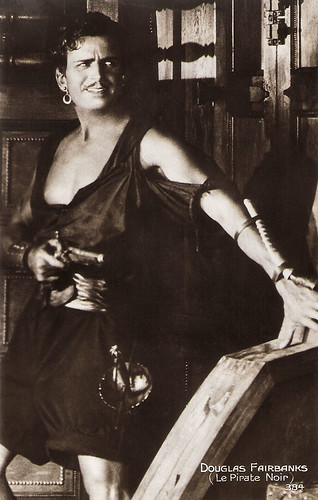
French postcard by Cinémagazine-Edition, Paris, no. 384. Photo: United Artists / Projectograph-Film. Publicity still of Douglas Fairbanks in The Black Pirate (Albert Parker, 1926).
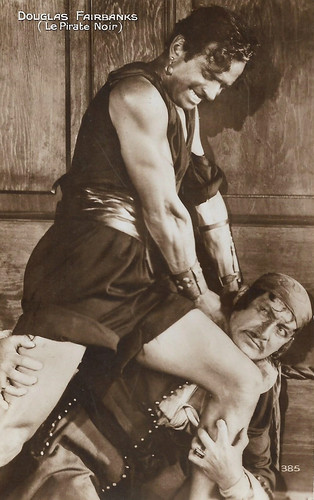
French postcard by Editions Cinémagazine, no. 385. Photo: United Artists. Publicity still of Douglas Fairbanks in The Black Pirate (Albert Parker, 1926).
The Black Pirate (Albert Parker, 1926) begins with the looting of a ship already captured and badly mauled, by a band of bloodthirsty pirates. After relieving the ship and crew of valuables, the pirates bind the captives, blow up the gunpowder on board, and sink the ship. "Dead men tell no tales!" While the pirates celebrate, two survivors wash up on an island, the old Duke of Arnoldo and his son Michel (Douglas Fairbanks). Before dying, the old man gives his signet ring to his son, which Michel later uses to prove his identity. The young man buries his father, vowing vengeance: "My father I solemnly vow".
The nasty pirate captain (Anders Randolf) and and his lieutenant (Sam De Grasse) bring some crew to the other side of the same island to bury some of their plunder in an underwater cave. They then plan to murder the other pirates: "Dead men tell no tales." But first, Michel appears as the 'Black Pirate', who offers to join their company and fight their best man to prove his worth. After much fighting, the Black Pirate kills the captain.
The pirate lieutenant sneers, and says there is more to being a pirate than sword tricks. To further prove his worth, the Black Pirate says he will capture the next ship of prey single-handed, which he does. He then uses his wits to prevent the pirates from blowing up the ship along with the crew and passengers, suggesting that they hold the ship for ransom.
When a beautiful woman (Billie Dove) is discovered on board, the pirate lieutenant claims her. In love at first sight, the Black Pirate finds a way to temporarily save her from this fate by presenting her as a 'princess' and urging the crew to use her as a hostage to ensure their ransom will be paid, as long as she remains "spotless and unharmed".
The pirates cheer the Black Pirate, and want to name him captain. The pirate lieutenant jeers but consents to wait to see if the ransom is paid by noon the next day. However, he secretly has a confederate destroy the ransom ship later that night to ensure it will not return. Then, when the Black Pirate is caught trying to release the woman, the Pirate Lieutenant exposes him as a traitor and the pirates force him to walk the plank.
At noon the next day, with the ransom ship having failed to show, the pirate lieutenant goes to the woman to claim his prize. But just then, the Black Pirate, who with the help of the sympathetic one-armed pirate MacTavish (Donald Crisp) had survived being sent overboard, returns leading troops to stop the pirates. After a long fight, the pirates are routed. In the end, the Black Pirate is revealed to be a Duke, and the 'Princess' he loves a real noble Lady. Even MacTavish is moved to tears of joy by the happy ending.
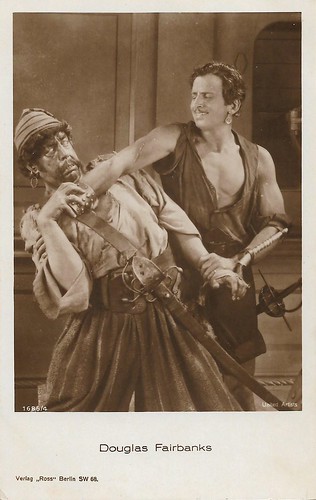
German postcard by Ross Verlag, no. 1686/1, 1927-1928. Photo: United Artists. Publicity still of Douglas Fairbanks in The Black Pirate (Albert Parker, 1926).

German postcard by Ross-Verlag, no. 1686/3, 1927-1928. Photo: United Artists. Publicity still for The Black Pirate (Albert Parker, 1926).
The Black Pirate (Albert Parker, 1926) is a fast-moving, exciting and thrilling Swashbuckler and one of Douglas Fairbanks' greatest films. It has all the classic ingredients of a pirate adventure: swordplay, torture, murder, robbery, kidnapping, romance with a princess, and even walking the plank. The stunts are still amazing today. Ron Oliver at IMDb: "Can any other swashbuckler top the flair or élan of the sequence where Doug captures a merchantman single-handed, climbing up the forecastle & sliding down the slit sails on his dagger, light as any sprite?" Fairbanks was already 43 when he performed this extraordinary stunt.
In addition, Fairbanks himself is the screenwriter of this rollicking adventure, using the pseudonym Elton Thomas. His scenario offers plenty of action – pirate raids, duels, even underwater photography The underwater swim by the seamen who arrived by longboat to help Fairbanks' character defeat the pirates, is an amazing scene, beautifully shot and daringly choreographed. United Artists Pictures offered a big budget and Fairbanks and his director Albert Parker used it for wonderful stunts and impeccable production values, such as appropriate ship shots and miniature sets.
Fairbanks felt that a pirate film had to be shown in colour. So The Black Pirate was filmed by Henry Sharp in two-tone Technicolor. This experimental colour system had been introduced in the feature Toll of the Sea (1922), and The Black Pirate was the third film to be produced in the process. Two-tone Technicolor reproduces a limited but pleasing range of colours. In the restored version, the bright red colour of blood is almost shocking to see, and the colours work well in the sweeping shots of the ocean and the ships at sea.
The sword-play in the film is dynamic and exciting and would influence many future Swashbuckler films. According to film historian Rudy Behlmer on the commentary track with the Kino DVD, Fred Cavens, the fencing master hired by Fairbanks became a staple of the industry. He later worked on such films as Captain Blood (Michael Curtiz, 1935) and The Adventures of Robin Hood (Michael Curtiz, William Keighley, 1938, both starring Errol Flynn.
The charismatic and athletic Fairbanks gives a bravura performance in the film, but the supporting cast also does a good job. Anders Randolf is an appropriately sinister villain. Truly hissable, he comes close to stealing the show in places. Sam de Grasse is also fine as the cunning lieutenant who chafes under The Black Pirate's leadership. Donald Crisp is funny as the salty old pirate who befriends Fairbanks. But Billie Dove plays a fairly typical damsel in distress type as the Princess. Her role is limited to looking pretty and swooning at the right moments.
Reportedly Douglas Fairbanks' wife, Mary Pickford forbade her husband from kissing another woman, including any actress in his films. The final scene of The Black Pirate called for Fairbanks to kiss the Princess. So Mary was suitably costumed and facing away from the camera, she performed the final embrace herself as a stand-in for Billie Dove.

German postcard by Ross Verlag, no. 4777/1, 1929-1930. Photo: United Artists. Publicity still of Douglas Fairbanks in The Black Pirate (Albert Parker, 1926).
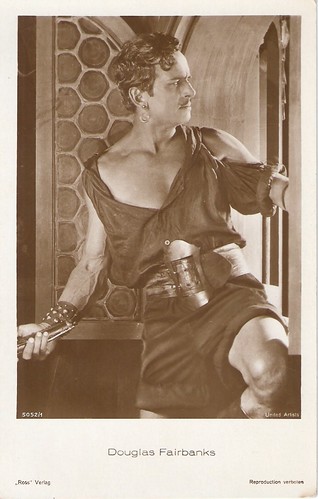
German postcard by Ross Verlag, no. 5052/1, 1930-1931. Photo: United Artists. Publicity still for The Black Pirate (Albert Parker, 1926).

Austrian postcard by Iris Verlag, no. 990. Photo: United Artists / Projectograph-Film. Publicity still for The Black Pirate (Albert Parker, 1926).
Sources: Wikipedia and IMDb.

Austrian postcard by Iris Verlag, no. 990. Photo: United Artists / Projectograph-Film. Publicity still of Douglas Fairbanks in The Black Pirate (Albert Parker, 1926).

French postcard by Cinémagazine-Edition, Paris, no. 384. Photo: United Artists / Projectograph-Film. Publicity still of Douglas Fairbanks in The Black Pirate (Albert Parker, 1926).

French postcard by Editions Cinémagazine, no. 385. Photo: United Artists. Publicity still of Douglas Fairbanks in The Black Pirate (Albert Parker, 1926).
Dead men tell no tales!
The Black Pirate (Albert Parker, 1926) begins with the looting of a ship already captured and badly mauled, by a band of bloodthirsty pirates. After relieving the ship and crew of valuables, the pirates bind the captives, blow up the gunpowder on board, and sink the ship. "Dead men tell no tales!" While the pirates celebrate, two survivors wash up on an island, the old Duke of Arnoldo and his son Michel (Douglas Fairbanks). Before dying, the old man gives his signet ring to his son, which Michel later uses to prove his identity. The young man buries his father, vowing vengeance: "My father I solemnly vow".
The nasty pirate captain (Anders Randolf) and and his lieutenant (Sam De Grasse) bring some crew to the other side of the same island to bury some of their plunder in an underwater cave. They then plan to murder the other pirates: "Dead men tell no tales." But first, Michel appears as the 'Black Pirate', who offers to join their company and fight their best man to prove his worth. After much fighting, the Black Pirate kills the captain.
The pirate lieutenant sneers, and says there is more to being a pirate than sword tricks. To further prove his worth, the Black Pirate says he will capture the next ship of prey single-handed, which he does. He then uses his wits to prevent the pirates from blowing up the ship along with the crew and passengers, suggesting that they hold the ship for ransom.
When a beautiful woman (Billie Dove) is discovered on board, the pirate lieutenant claims her. In love at first sight, the Black Pirate finds a way to temporarily save her from this fate by presenting her as a 'princess' and urging the crew to use her as a hostage to ensure their ransom will be paid, as long as she remains "spotless and unharmed".
The pirates cheer the Black Pirate, and want to name him captain. The pirate lieutenant jeers but consents to wait to see if the ransom is paid by noon the next day. However, he secretly has a confederate destroy the ransom ship later that night to ensure it will not return. Then, when the Black Pirate is caught trying to release the woman, the Pirate Lieutenant exposes him as a traitor and the pirates force him to walk the plank.
At noon the next day, with the ransom ship having failed to show, the pirate lieutenant goes to the woman to claim his prize. But just then, the Black Pirate, who with the help of the sympathetic one-armed pirate MacTavish (Donald Crisp) had survived being sent overboard, returns leading troops to stop the pirates. After a long fight, the pirates are routed. In the end, the Black Pirate is revealed to be a Duke, and the 'Princess' he loves a real noble Lady. Even MacTavish is moved to tears of joy by the happy ending.

German postcard by Ross Verlag, no. 1686/1, 1927-1928. Photo: United Artists. Publicity still of Douglas Fairbanks in The Black Pirate (Albert Parker, 1926).

German postcard by Ross-Verlag, no. 1686/3, 1927-1928. Photo: United Artists. Publicity still for The Black Pirate (Albert Parker, 1926).
Walk the plank
The Black Pirate (Albert Parker, 1926) is a fast-moving, exciting and thrilling Swashbuckler and one of Douglas Fairbanks' greatest films. It has all the classic ingredients of a pirate adventure: swordplay, torture, murder, robbery, kidnapping, romance with a princess, and even walking the plank. The stunts are still amazing today. Ron Oliver at IMDb: "Can any other swashbuckler top the flair or élan of the sequence where Doug captures a merchantman single-handed, climbing up the forecastle & sliding down the slit sails on his dagger, light as any sprite?" Fairbanks was already 43 when he performed this extraordinary stunt.
In addition, Fairbanks himself is the screenwriter of this rollicking adventure, using the pseudonym Elton Thomas. His scenario offers plenty of action – pirate raids, duels, even underwater photography The underwater swim by the seamen who arrived by longboat to help Fairbanks' character defeat the pirates, is an amazing scene, beautifully shot and daringly choreographed. United Artists Pictures offered a big budget and Fairbanks and his director Albert Parker used it for wonderful stunts and impeccable production values, such as appropriate ship shots and miniature sets.
Fairbanks felt that a pirate film had to be shown in colour. So The Black Pirate was filmed by Henry Sharp in two-tone Technicolor. This experimental colour system had been introduced in the feature Toll of the Sea (1922), and The Black Pirate was the third film to be produced in the process. Two-tone Technicolor reproduces a limited but pleasing range of colours. In the restored version, the bright red colour of blood is almost shocking to see, and the colours work well in the sweeping shots of the ocean and the ships at sea.
The sword-play in the film is dynamic and exciting and would influence many future Swashbuckler films. According to film historian Rudy Behlmer on the commentary track with the Kino DVD, Fred Cavens, the fencing master hired by Fairbanks became a staple of the industry. He later worked on such films as Captain Blood (Michael Curtiz, 1935) and The Adventures of Robin Hood (Michael Curtiz, William Keighley, 1938, both starring Errol Flynn.
The charismatic and athletic Fairbanks gives a bravura performance in the film, but the supporting cast also does a good job. Anders Randolf is an appropriately sinister villain. Truly hissable, he comes close to stealing the show in places. Sam de Grasse is also fine as the cunning lieutenant who chafes under The Black Pirate's leadership. Donald Crisp is funny as the salty old pirate who befriends Fairbanks. But Billie Dove plays a fairly typical damsel in distress type as the Princess. Her role is limited to looking pretty and swooning at the right moments.
Reportedly Douglas Fairbanks' wife, Mary Pickford forbade her husband from kissing another woman, including any actress in his films. The final scene of The Black Pirate called for Fairbanks to kiss the Princess. So Mary was suitably costumed and facing away from the camera, she performed the final embrace herself as a stand-in for Billie Dove.

German postcard by Ross Verlag, no. 4777/1, 1929-1930. Photo: United Artists. Publicity still of Douglas Fairbanks in The Black Pirate (Albert Parker, 1926).

German postcard by Ross Verlag, no. 5052/1, 1930-1931. Photo: United Artists. Publicity still for The Black Pirate (Albert Parker, 1926).

Austrian postcard by Iris Verlag, no. 990. Photo: United Artists / Projectograph-Film. Publicity still for The Black Pirate (Albert Parker, 1926).
Sources: Wikipedia and IMDb.
No comments:
Post a Comment